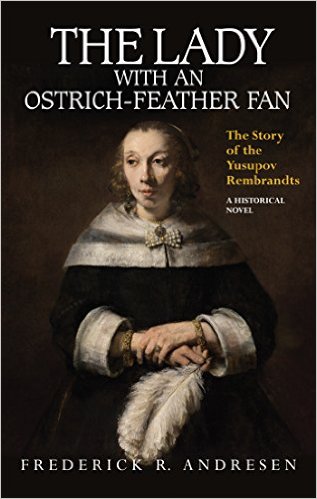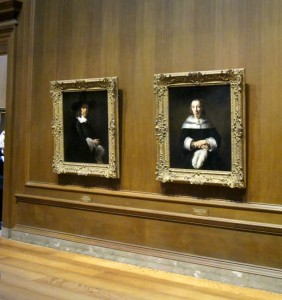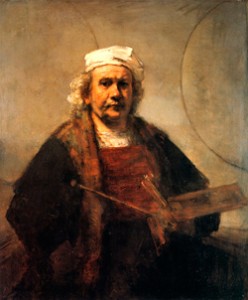The Lady with an Ostrich-Feather Fan: The Story of the Yusupov Rembrandts by Frederick R. Andresen recounts the inception and life history of two of Rembrandt’s most celebrated masterpieces: The Lady with an Ostrich-Feather Fan and Portrait of a Gentleman with Tall Hat and Gloves. The story takes us through the centuries, through country upheavals, and the ongoing responsibility to protect these exquisite portraits by courageous female protagonists charged with seeing to the welfare and care of these important works of art. Historically fascinating, this novel shows us the long enduring struggle great artworks and their caretakers have weathered as well as the demands of familial ties.
The story explores what those in search of gaining or maintaining societal status will suffer in the name of art, family, and personal honor. They risk their lives to preserve these family treasures, to keep them safe from the threats of revolution, obsessive parties, personal interests, and finally American law — until the paintings find a place to call home.
The book is unique in its scope of recreating the history behind these two important paintings and what they and their family custodians endured through the centuries so that we today are now blessed with the ability to enjoy and view these extraordinary masterpieces.
Stephanie Renee dos Santos: Will you please tell us about the unique structuring of the novel? Why did you chose this particular format?
Frederick Andresen: The format is dictated by the long, exciting, and sometime perilous journey of these extraordinary paintings. The Rembrandts and their descendant family of caretakers witnessed critical points of history and were threatened by life-changing events. While the time zones of these 282 years and evolving historic places can be divided into six ages, the story still fits into a broadly expressed dramatic three acts. The format is natural as the story is based on actual facts and historic events.
Act 1 Holland: The life expectation of portraits being painted, the artistic immortalization by Rembrandt, the sudden death of the woman, the ups and downs of the Dutch Golden Age, the paintings’ removal via auction to Paris where the Russian connection occurs as the “Lady” and the “Gentleman” escape the threat of the French Revolution and are taken to “safe” Russia by the famed and rich Yusupov family.
Act 2 Russia: The Rembrandts and their protecting family ownership over the entire eighteenth century, the dramatic threats from war and domestic uprising and the eventual fall of the Russian Empire, including the murder of the notorious monk, Rasputin, by the controversial Felix Yusupov who then escaped sure death with his jewels and the Rembrandts, to London.
Act 3 The Western Art World: The future of the Rembrandts at the whim and tactics of possessive art collectors, agents, and a scheming Felix Yusupov, ending in a New York courtroom where the art is possessed by the famous Widener family who finally give the entire collection to the new Mellon museum in Washington, DC., the 1942 wartime opening days of the National Gallery of Art where representatives of the Dutch legation view the art, along with the woman Dutch official who is a direct descendent of the woman in the portrait.
SRDS: What compelled you to include art and artist in your historical novel?
 FA: One afternoon I was in the National Gallery of Art in Washington, DC and I happened to call a friend who asked me if I knew of the Yusupov Rembrandts. I said, “No,” so I went to see these famous portraits. In about an hour I had the start of a story. Why? It was the eyes—the eyes of the lady in Portrait of a Lady with an Ostrich- Feather Fan and her partner in Portrait of a Gentleman with Tall Hat and Gloves. They set me wondering about the message in the eyes of those mysterious characters, especially the eyes of the woman—Rembrandt’s woman.
FA: One afternoon I was in the National Gallery of Art in Washington, DC and I happened to call a friend who asked me if I knew of the Yusupov Rembrandts. I said, “No,” so I went to see these famous portraits. In about an hour I had the start of a story. Why? It was the eyes—the eyes of the lady in Portrait of a Lady with an Ostrich- Feather Fan and her partner in Portrait of a Gentleman with Tall Hat and Gloves. They set me wondering about the message in the eyes of those mysterious characters, especially the eyes of the woman—Rembrandt’s woman.
The driving force was The Lady with an Ostrich-Feather Fan painting and the story wanting to come out from behind those eyes. When I questioned NGA Curator Arthur Wheelock, Jr., I could see the path for a story was open to explore.
SRDS: What drew you to your specific visual art medium, artwork, and/or artist?
FA: Rembrandt! What else! But also the environment of The Golden Age, Holland’s magnificent seventeenth century. And what was to follow in European history and the how the art was protected and guided through that tumultuous time — 282 years until the paintings find their home in the NGA.
SRDS: What unique historical objects, places and/or documents inspired the story?

Moika Palace of the Yusupov family in St. Petersburg with the largest art collection in Imperial Russia, including the two portrait Rembrandts, called home in the late 1800s
FA: The Dutch Golden Age, Czar Peter the Great’s visit to Holland, The French Revolution, the historic Yusupov family, the Russian 19th Century especially in St. Petersburg, The Russian Revolution and fall of the aristocracy, the murder of Rasputin, post war England and America, The Widener family, the founding of the National Gallery of Art by Mellon.
SRDS: Is there an art history message you’ve tried to highlight within the novel?
FA: The art history message is that there is so often a history to art, surely unexpected or known to the artist, and often unnoticed by the succeeding owners, museums, etc. And history is filled with that entertaining trick called “unintended consequences.”
SRDS: What do you think readers can gain by reading stories with art tie-ins?
FA: The art subject is an innocent character in an unpredictable series of events. In well-written historical fiction, the fiction becomes real, and the history is seen through new eyes.
SRDS: What fascinating information did you uncover while researching but were unable to incorporate into the book, but can share here?
FA: Oh, so much. There is the story of the “Seven Rembrandts” and the one about “Coco Chanel and who? Rasputin?”
It is amazing how things “happen.” As a side event to the Russian Revolution, a deciding one in some people’s minds, was the murder of the mystic Gregori Rasputin by, it was popularly assumed, Prince Felix Yusupov. In my historical novel The Lady with an Ostrich-Feather Fan, this short side-story actually took place after that famous murder. But my story here is not about Prince Felix Yusupov or even Rasputin, both of whom figure largely in my book. This is about a happening that resulted from the Yusupov/Rasputin affair—an “unintended consequence” as they say. In researching and writing, many side stories surface, some new and some known. This is a truthful and fun one.
It involves Grand Duke Dimitri Pavlovich, first cousin of Czar Nicolas II, and who was one of the handful of conspirators, led by Prince Felix Yusupov, who murdered Rasputin in the basement room of the Yusupov Palace on the Moika in Saint Petersburg in December, 1916. Czar Nicholas II sent the murdering conspirators far out of town and Dimitri was sent to a military unit in Persia. In the next year, 1917, it was all over for Czarist Russia and the Grand Duke never returned to his homeland. Like many other fleeing Russians, he ended up in Paris. And who do you think took notice of the aristocrat’s arrival? Coco Chanel. She was eleven years his senior but that didn’t stop either one.
The French perfume business was booming because the scents didn’t last past eleven in the evening. So they bathed in the stuff. (Can you imagine?) However, as I heard the story, Dimitri said to Coco that she should not sell big bottles of perfume for cheap prices, but small bottles for high prices. There is much written about this affair. Dimitri introduced Coco to Ernest Beaux, a successful Russian-born perfumier from St. Petersburg. Beaux’s grandfather was part of the Napoleon invasion of Russia in 1812, was captured by the Russians and upon release, decided to stay there. Ernest Beaux found himself in France after World War 1. His French employer, Rallet, would not follow his suggestions. From his Russian experience, Beaux insisted that the addition of deer musk would make the perfume last the night. On Dimitri’s suggestion, Coco hired Beaux, added deer musk to the eighty-some other ingredients and voilà- we have Chanel No. 5. That was 1920.
The Coco-Dimitri affaire lasted a year and while she moved on to others, the relationship is indeed historic. You may have seen the film “Igor and Coco” about her affair with Stravinsky. It seems she liked Russians—famous Russians. But as an unintended consequence of the murder of Rasputin, our lovely ladies have Chanel No. 5. Ce qui arrive, arrive.
To read more about all this read Chanel by Edmonde Charles~Roux.
SRDS: Any further thoughts on art in fiction you’d like to expand on?
FA: “The painting is not over until the viewer walks away.” I don’t know the source, but it comes out in Act 1, the painting by Rembrandt. This is true and because the viewer, each viewer in fact, may well come away with a different message or feeling, it is story, you can call it fiction. So as art may move to varying cultural environments, the reaction, the message changes.
SRDS: Are you working on a new historical novel with an art tie-in? If so, will you share a little with us about your next release?
FA: Oh yes, but let’s first get the present “art in fiction” story published and in the hands of the reader. But, yes, there is a new idea. In The Hermitage is the famed painting by Rembrandt of The Prodigal Son. That parable of Jesus is my favorite—what a story! When one looks deeper into the possible mind of Rembrandt and his last years, this being his last painting, what are the signals in the painting. After long study of the painting, I have a story and one which is universal and eternal. And I plan to set it in early California. But first, The Lady with the Ostrich Feather Fan will see the light.
 About the author: Fred Andresen draws on a lifetime of international adventure and travel. A businessman in Asia, Europe and Russia, he founded his success on understanding the people, their history, and their stories. He lived in Russia for six years and has continued to maintain an interest there for the last twenty years. He writes historical fiction and non-fiction: The Lady with an Ostrich-Feather Fan: The Story of the Yusupov Rembrandts; Walking on Ice: An American Businessman in Russia (2007), which details his Russian experience with an “openly Chekhovian” narration, according to Andrei Zolotov, Jr., of Russia Profile; Dos Gringos (2010) is a true and hilarious account of his Norwegian immigrant father’s escapades in The Mexican Revolution. “A Norwegian and an Irishman meet in a Texas bar…” His essays and short stories have appeared in magazines in Russia, England, and America.
About the author: Fred Andresen draws on a lifetime of international adventure and travel. A businessman in Asia, Europe and Russia, he founded his success on understanding the people, their history, and their stories. He lived in Russia for six years and has continued to maintain an interest there for the last twenty years. He writes historical fiction and non-fiction: The Lady with an Ostrich-Feather Fan: The Story of the Yusupov Rembrandts; Walking on Ice: An American Businessman in Russia (2007), which details his Russian experience with an “openly Chekhovian” narration, according to Andrei Zolotov, Jr., of Russia Profile; Dos Gringos (2010) is a true and hilarious account of his Norwegian immigrant father’s escapades in The Mexican Revolution. “A Norwegian and an Irishman meet in a Texas bar…” His essays and short stories have appeared in magazines in Russia, England, and America.
He is a Director of Chamber Orchestra Kremlin and was president of the Los Angeles- St. Petersburg Sister City Committee. A graduate of Thunderbird School of Global Management and Colorado State University.
A guiding motto of Fred‘s adventures and storytelling is Robert Frost’s “Two roads diverged in a wood, And I took the one less traveled by, And that has made all the difference.”
For more about Fred’s works:
To buy: The Lady with an Ostrich-Feather Fan: The Story of the Yusupov Rembrandts
Join us here August 26th for an interview with Laura Morelli, author of The Gondola Maker!
Interview posting schedule:
2014: August 30th Susan Vreeland, Lisette’s List (new release), September 27th Anne Girard, Madame Picasso (new release),October 25th Yves Fey, Floats the Dark Shadow, November 29th Mary F. Burns, The Spoils of Avalon (new release), December 27th Kelly Jones, The Woman Who Heard Color
2015: January 31st Heather Webb, Rodin’s Lover (new release), February 28th Alyson Richman, The Mask Carver’s Son, March 28th Maureen Gibbon, Paris Red (new release), April 11th M.J Rose, The Witch of Painted Sorrows (new release), April 25th Lisa Brukitt, The Memory of Scent, May 30th Lisa Barr, Fugitive Colors, June 27th Nancy Bilyeau, The Tapestry (new release) , July 25th Andromeda Romano-Lax, The Detour, August 29th Frederick Andresen,The Lady with an Ostrich Feather Fan, September 26 Laura Morelli, The Gondola Maker
Join Facebook group “Love of Arts in Fiction”!



